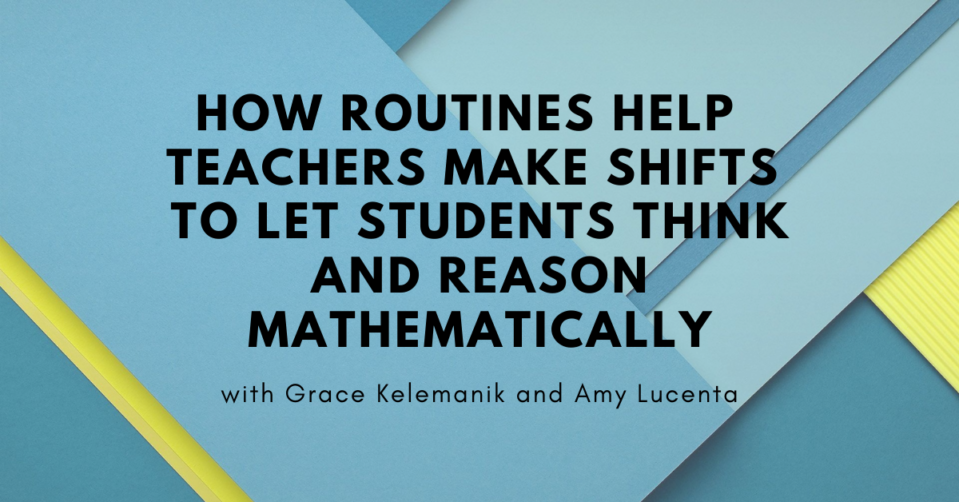
Teaching students to think and reason mathematically is sometimes a challenge. This is where instructional routines come in.
Today on the podcast we’re joined by Grace Kelemanik and Amy Lucenta. In 2016 Grace and Amy co-authored Routines for Reasoning, where they framed routines as key to developing mathematical thinking skills. Their new book, Teaching for Thinking: Fostering Mathematical Teaching Practices Through Reasoning Routines, picks up where their first book left off, revealing how routines can enhance our classroom instruction.
Today, Grace and Amy examine how educators can make use of routines to make fundamental shifts in their teaching practice.
Below is a transcript of this episode.
Steph: Grace and Amy, thank you so much for joining me to talk about your new book Teaching for Thinking. I'd like to start by asking just what led you to the decision to write Teaching for Thinking after your previous book, Routines for Reasoning, which was just such a great success for mathematical teaching. So what are some of the similarities between these two books and what differentiates them?
Amy: Yeah, that's a great question. It's actually somewhat of an evolution between Routines for Reasoning and Teaching for Thinking. In routines for reasoning, Grace and I focused on developing math practices and being really explicit about the standards for mathematical practice and developing mathematical thinking, and the kinds of supports to engage and support every learner. And so all of our routines in Routines for Reasoning did that. They focused on the thinking. They had specific supports, which we call essential strategies, to engage all learners in the thinking, and it was so fun to see those routines getting into classrooms and getting into action. And we started to notice that when teachers implemented the routines, they actually implemented teaching practices and they said they previously hadn't implemented them in the same way, that the routines allowed them to facilitate more student based discourse. The routines allowed them to give students processing time that oftentimes outside of the routine, they jumped over.
So it gave them the structure to follow to do the kinds of things they wanted to do for students and to teach in the ways they were striving to teach. The routines provided the structures to develop thinking and to make the thinking visible. And so we also started to see that the grain size of the routine was what we call pickupable and allowed teachers to learn the routine and bring it right into their classroom. And then the strategies that we have baked into the routines also provided these perfect grain size for teacher practice and goals to work on and repeatedly work on through the routine, as vehicles for their own development. And so with all of that, we started to see how the reasoning routines held this power for teachers to shift their practice. So we wanted to share a couple things in Teaching for Thinking. We had a couple new routines to share, actually one old fan favorite, contemplate then calculate, but two new ones.
We wanted to share those. And we wanted to shift our focus on how to leverage them to develop equitable teaching practices. And then also to give teachers tools to practice and develop the essential strategies within each routine, not just to do the routine, but use the routine now as a vehicle. So we did that in Teaching for Thinking, and we unpacked the design process, kind of pull back the curtain on how we build the routines and construct them and design them. Not just so teachers can understand the intricacies of the reasoning routines they've been working with, but also so they can actually design their own routine. No surprise that we have a bunch of threads running through the book, just like Routines for Reasoning, but the focus is different.
Steph: So you identify three necessary shifts for teaching mathematical thinking. The first is to focus on the thinking. You also name stepping out of the middle, and then, finally, support productive struggle. So can you tell me a little bit more about why these three shifts are necessary for mathematical thinking?
Grace: Sure. One of the things we noticed as we were trying of articulate what classrooms looked like when students were learning to think and reason is that teaching looks different. So if you are teaching for thinking, you have to make these sort of three big shifts in your practice. One is to place more focus on the thinking, as you said, step out of the middle of interactions in the classroom, and have students interacting with each other and really support productive struggle, provide access for students entryways in, and support them during the thinking. And so if we think about that first one, focusing on thinking, if we're going to teach students how to think and reason, we have to privilege the thinking that's happening in the classroom. It's not that students aren't thinking in the classroom, it's that we often don't make that thinking public.
We kind of start conversations with the answers, and how we got there. And so if you're teaching for thinking, you have to shift some of the focus and place more emphasis on that initial sense making that's going on, on students to talking with each other about how they're interpreting a problem, considering the potential approaches they might make on that problem, sharing questions they have. Students deciding together whether or not what they're doing and what their classmates are doing makes sense and is valid, and regularly reflecting on their and their classmates thinking. And so we just simply have to shift more focus onto the thinking, make it public, name it. And that means that we necessarily have to be orienting students to each other. If they're working with each other, reasoning through a problem, sharing how they're thinking about it, helping each other build on strategies in the classroom, then we want students to be listening to and working with each other.
And so as teachers, we need to kind of step out in the middle and orient students to what their classmates are saying and pick up the classmates ideas and work with them. And then I think one of the things we're fans of saying is that thinking takes time. You can't think fast. And so we need to kind of create space and structures for students to process ideas that are on the table, to grapple with concepts.
And so, in that way, Teaching for Thinking is more like a marathon and less like a sprint, right? So part of what we're doing, beyond building the capacity to think and reason, is to build students stamina to do it, and their confidence to think and reason mathematically. So all of this is to say the teacher's roles got to change then, right? Rather than being the one who's doing the explaining and the showing and the telling, the teacher's kind of stepping out of the middle and facilitating those interactions that are getting and keeping students thinking productively, so that the students start to see themselves and the mathematics as the mathematical authority in the classroom, rather than always turning to the teacher.
Steph: So just to rewind just a little bit, we've talked a lot about routines so far in the conversation. So in the context of your work, what is a routine and what purpose do these routines serve?
Amy: That's a great question because for educators, routines can mean so many different things, and ultimately they serve a common purpose, but ours are a little more specific reasoning routines we use to mean something a little more specific. And routines in general serve a wide variety, a plethora of roles in the classroom. We use them so that students know how to line up for recess, or how to turn in homework when they come in the room, or how to manage materials in the classroom. And for all of these, the purpose is to have a system in place so that the classroom functions fluidly and that learning can happen, and we can take more time for learning. And reasoning routines are similar, they have a similar purpose. They keep things steady and consistent, so the learning can happen. They set expectations clear, they repeat processes and structures, they have a familiarity so that both students and teachers can free up their minds to focus on mathematical thinking.
And so a reasoning routine, rather than, as Grace is fond of saying, rather than getting students to the learning, reasoning routines engage students in the learning. And so they provide a... We often refer to it and you can't see our hands in a podcast, but we both gesture this. If you could take your two hands and gesture a container, in this kind of cylindrical container, in which all the designs for interaction are held in that container. Designs between teachers and students, students and content, students and students, and all of those designs remain consistent. And you know that because as you can walk into classrooms and observe a reasoning routine and recognize it and walk into another classroom, see the students engaging the same ways in the same routine, following the same flow, they could be learning different content, they could be different grade levels, but you recognize the routine because those interactions stay the same.
And in particular, a reasoning routine focuses on reasoning. So the goal of it is always mathematical thinking and reasoning, and we can put different math tasks at the center of the routine, but all of the designs for interaction are such that the goal of the routine is to develop mathematical thinking. The beauty of routines, reasoning routines in particular, they free up students' minds, so the students are poised to develop mathematical thinking. They don't have to think about what's coming next, what they have to do next, or learn a new set of directions. And it frees up teachers minds to make decisions in the moment so that they're poised to develop that student thinking and be responsive to student thinking in the moment. And as we talk about in Teaching for Thinking as well, they also provide these vehicles for teachers to develop their own teaching practices.
Grace: I think Amy captured it really well, and I think the only thing I might add is just to lean into the routineness of it. The routines are meant to be repeated, and so therefore they're great at forming new habits, whether they're habits of thinking, if you're a student, or habits of teaching. So they're really wonderful vehicles for building practice in that way.
Steph: Yeah. And I love the highlight on how these routines can help teachers be responsive. I think that's so important. And as you detail these routines in Teaching for Thinking, you identify five essential strategies that are woven all throughout the routines. So you have annotation, asking yourself questions, the four Rs, which I'm very curious about, sentence starters and frames, and then turn and talks. So can you give us a brief overview of all of these?
Grace: Sure. Let me just see if I can give you the one sentence description of each of those five essential strategies, and then we can dig into them. So annotation is essentially using colors and markings to provide a visual that students can see, like a visual representation of the mathematical thinking their classmates are sharing in the classroom. So it brings in kind of that second modality. Ask yourself questions are just that. Questions that students learn to ask themselves that kind of orient them to productive ways to think about a problem and build independence as math doers and thinkers. The four Rs, we kind of chuckle often that we named this the four Rs because Amy and I are both outside of Boston where we tend to drop our Rs a lot. So naming something the four Rs where we actually have to use that letter in pronouncing is just practice for us.
So they are repeating, rephrasing, rewording, and recording. So they're basically discourse moves. By and large, they're done by students. So students repeating, rephrasing, and rewording their classmates ideas, and the teacher recording any important ideas on the board for reference. And they just build in repetition of ideas that students can hear and processing passes at ideas in the classroom. And then sentence frames and starters, folks know what those are. I think a lot of teachers use them. They're basically skeletons of the sentence that help students both organize their ideas to share, and also communicate their thinking more clearly. And then again, turn and talks is probably something familiar to listeners. Those are just opportunities for a student to work with a partner, to kind of work out their mathematical thinking and language.
Steph: And what's an example of how one of these strategies would support shifts in practice?
Amy: So we could take each one of these strategies and talk about how they support students first, but ultimately we're using them in Teaching for Thinking to support shifts in teacher practice. And so if we take a look at annotation, the first one Grace talked about, annotation being that representation of student thinking and in, say a full group discussion, and a teacher is capturing the essence of mathematical thinking. And you can imagine this discussion. You can imagine a different discussion, let's say, that raises all these great idea. As in students are sharing thinking, and it all happens in the air. And so that leaves some students really struggling to make sense of it and leaving them at a disadvantage to build their own thinking during it. Annotation supports those students and in doing so, the teacher is authentically listening to student ideas.
So they're not annotating what they think a student should say, but rather they're responsive to what a student's sharing, and purposefully highlighting the mathematical thinking that they're sharing. They're not recording every little thing a student says, but stepping out of the middle and using color symbols purposefully to highlight students mathematical thinking. Because teachers are annotating the thinking, they're focusing on the thinking. And so the annotation, if they're developing, say, structural thinking, the annotation represents structural thinking. It also provides multiple modalities, as Grace mentioned. So students aren't just hearing what's happening in the room, they're seeing something. They're having annotation to ground what they're hearing, and they're provided with some visual residue of the discussion. So even if they had to go get a sip of water during the discussion and come back, there's visual residue of the discussion. If they didn't quite hear something that was said, or they're struggling to make sense of it a little bit, and they see the annotation and the color and the organization, and it's supporting their productive struggle.
So that's kind of, in a nutshell, how annotation can support these three shifts. And as Grace mentioned, it is a strategy that's built into the routines and then we can practice regularly and consistently when we implement one of the routines and that's really how it's going to create a shift rather than just a one off, oh today in class, I annotated, versus oh, I annotate when I use these routines. And now I'm focusing on thinking, stepping out of the middle and supporting productive struggle in a regular and repeatable way.
Grace: And then hopefully we see those essential strategies breaking the boundaries of the routine, and entering all math lessons, because it's just become a habit, a new teaching habit.
Steph: So, finally, there are three routines that you identify in this book. Can you introduce us to each of them and describe just how they support teachers in making these shifts to help students think and reason mathematically?
Grace: So we have three, I mean, Amy sort of said this at the beginning, I'm new and I'm doing air quotes, new routines in the book, new to print, I guess, is how we'll say it. One is contemplate then calculate, which has been around for a long time, we've just never wrote it up, and folks had kind of asked for it to be written up. So it's in this book. Contemplate then calculate is a reasoning routine designed to develop structural thinking. And we often talk about it as breaking students compulsion to calculate. Build a habit of pausing and interpreting mathematics, a mathematical object, noticing what's mathematically important about it. And then using those noticings in the case of contemplate then calculate, to find a short or a more elegant way to solve a problem. The second routine that's in the book is a new one. It's called decide and defend.
And the purpose of creating this routine was to support students to develop that standard for mathematics practice, construct viable arguments and critique the reasoning of others. So decide and defend positions students to make sense of someone else's work or argument, decide if they agree with it or not, and then defend that decision. And throughout that process, they are building their capacity to critique and construct viable arguments. And then the last routine that's in the book, a new one for us, is called analyzing context and models. And that routine is really building students capacity to, as we like to say, mathematize their world, model with mathematics, to make sense of the world around them, particularly prickly context with lots of variables, and it makes sense of it.
And then consider a mathematical model that can be used to answer questions about that context and sort of think about the efficacy of that model. How well does it do what we want it to do and how might we revise it to work better? So those are the three routines in the new book, Teaching for Thinking, and they all have these five essential strategies woven throughout them. And so while you're using the routines, you are posing ask yourself questions, annotating, engaging students in the four Rs, turn and talks, and the use of sentence frames and starters, to keep the focus on the thinking step out of the middle and support productive struggle.
 Grace Kelemanik has more than 30 years of mathematics education experience. A frequent presenter at national conferences, her work focuses on urban education, special populations, and teacher training. She is a former urban high school mathematics teacher and Project Director at Education Development Center. Grace has also worked extensively with new and preservice teachers through the Boston Teacher Residency program.
Grace Kelemanik has more than 30 years of mathematics education experience. A frequent presenter at national conferences, her work focuses on urban education, special populations, and teacher training. She is a former urban high school mathematics teacher and Project Director at Education Development Center. Grace has also worked extensively with new and preservice teachers through the Boston Teacher Residency program.
Most recently, Grace is the coauthor of Routines for Reasoning: Fostering the Mathematical Practices in All Students. She is also coauthor of The Fostering Geometric Thinking Toolkit. She is a mathematics education consultant and professional development provider.
Follow Grace on Twitter @GraceKelemanik
 Amy Lucenta has extensive K–12 mathematics experience with all students, including a focus on special populations. She is a frequent professional development provider who helps teachers implement the Standards for Mathematical Practice. Amy is the coauthor of Routines for Reasoning: Fostering the Mathematical Practices in All Students.
Amy Lucenta has extensive K–12 mathematics experience with all students, including a focus on special populations. She is a frequent professional development provider who helps teachers implement the Standards for Mathematical Practice. Amy is the coauthor of Routines for Reasoning: Fostering the Mathematical Practices in All Students.
Follow Amy on Twitter @AmyLucenta


